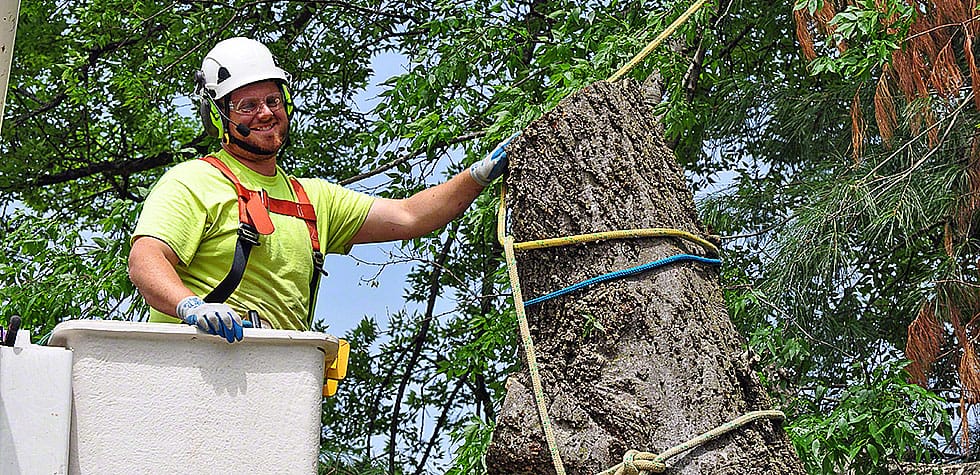
Oak trees are one of the most beautiful types out there. These trees can grow to immense heights with green leaves and branches leaving the viewers stunned. Although, oak trees are strong but like other trees can catch diseases that might lead to death. Here are some important signs of your oak tree dying and what you can do to prevent it. To save time, consult arborist services.
Spots On Early Leaves
Spots on early leaves are usually caused by Anthracnose, which is a sign that the tree is not going well. However, it does not mean that the tree is dying or is dead. The tell-tale sign of Anthracnose on an oak tree is that you will spot brown or yellow spots along the veins of the leaf.
It might also be that the leaves start turning into a cup shape or begin feeling like paper. If you are not sure, you can wait a day or two for other signs to show up as well. However, if you want to begin treating the tree, start by removing the leaves and branches to prevent the disease from spreading.
Blotches On Leaves
If you have an oak tree near your house that you love to take care of, take a close look at its leaves the next time you are out for a walk. You might spot what are called blotches on leaves also known as sprawling spots or Tubakia Leaf Spots. These spots are brown/orange in color and are quite prominent in young trees.
In this case, the tree will actually appear blotchy. However, in older trees, the blotches could be relatively larger. And, if the blotches exist along the veins of the oak tree leaves, the leaves will eventually begin to fall.
The best way to treat the tree is by pruning the affected leaves and branches. Plus, consult an arborist and make sure to monitor the tree closely for a while.
Yellow, Dull Green, Or Brown Perimeter On Leaves
If you notice that your oak tree leaves have unusually colored edges, it is usually a sign of Oak Wilt. Yellow, Dull Green or Brown Perimeter on leaves are early signs that the tree is distressed. If the problem is ignored, the leaves will eventually fall and you won’t be able to stop that from happening until the condition turns worse.
Eventually, without the leaves, the tree will not be able to carry out photosynthesis leading to its death. Keep in mind that Oak Wilt is a lot more deadly for Red Oaks. In fact, Red Oaks tend to last hardly a month if Oak Wilt occurs. However, that is not the case with White Oaks.
Furthermore, Oak Wilt is caused by oak bark beetles in warmer temperatures. These beetles feed on their host trees and release decay fungi that leads to wilt. The treatment depends on the intensity of the Oak Wilt. If the condition is controllable, trenching is one solution.
However, a trunk injection can also be used to stop the spreading of the disease.
Puckered Areas On Leaves
Oak Leaf Blister looks like any other blister except the fact that it is on the leaves. In the early stages, the blisters won’t cause much change in the colors but the texture will surely feel bumpy. In addition to that, the longer the blisters are on the leaves, the browner they will get, eventually leading to a point where they will curl and fall.
However, you can easily stop the spreading by removing the affected branches or leaves and keeping the area surrounding the tree clean. Even the dead leaves on the ground could spread the disease. So, make sure to rake and remove them.
Swollen Branches Or Trunk
Swollen Branches or Trunk also known as Crown Gall tend to be one of the most common symptoms of a dying oak tree. Crown Gall causes the stems, roots, and branches to look swollen and round. It is quite noticeable as it appears as a big bulge on the tree.
In the initial stages, it might be spongy but will eventually turn harder with time. The best way to treat Crown Gall is by maintaining the tree and injecting chemicals to kill the bacteria. Above all, make sure the tree does not have any open wounds.
Moreover, it could also prove lethal if it appears near the root crown. In that case, you should turn to tree removal companies Potomac for the removal of the tree.
White Textured Spotting
White textured spotting is usually caused by Armillaria Root Rot and appears as a white, yeasty substance on the branches and bark of the tree. It is caused by a certain type of fungi and will result in the tree losing its leaves to the point where it will eventually die since the growth is stopped.
Armillaria Root Rot is difficult to observe or detect as it is usually present under the bark. However, you might notice brown or red clusters of mushrooms growing around the base of the tree. The solution to this Root Rot is to make sure there is no flooding and the tree has strong fertile health.
How To Prevent An Oak Tree From Dying?
Now that we have discussed the signs of a dying oak tree, it is important that you are aware of some prevention tips as well. Here is what you can do to keep your Oak Tree alive.
Keep The Grass Away
Planting an oak tree in a grassy area can create problems. The reason is that grass will take away water, air, and nutrients from the tree. In the early stages, it is a good idea to plan the tree or remove grass from the area where the tree is planted.
This is because the tree is vulnerable and needs water and essential nutrients to grow and gain strength. If that is not the case, the tree might still grow but won’t be as strong.
Provide Plenty Of Water
Oak trees require slightly more water than the other types. Then again, in the early stages, you will need to be extra careful. If the weather is extremely hot, you will need to water it at least every day. Keep an eye on the soil drainage. If the water dries fast, you will need to increase the watering frequency.
Properly Pruning The Tree
Proper pruning is essential for a tree to grow healthy. However, in the case of new oak trees, they do not require much pruning. If you observe the branches getting too low to the ground, you will need to prune them. At the same time, pruning dead leaves or branches will help keep the tree in perfect condition.
Hire An Arborist
An arborist can inspect the health of your oak tree to tell you if you can save it. If not, they will give the details of tree removal experts.
Conclusion
There are many signs that indicate your oak tree is dying. However, sometimes you can save the tree by following the tips mentioned above or if the condition has turned worse, remove it with the help of tree cutting services Bethesda. At the same time, you can prevent such situations by looking after the tree and consulting an expert to keep it in perfect health for years to come.



